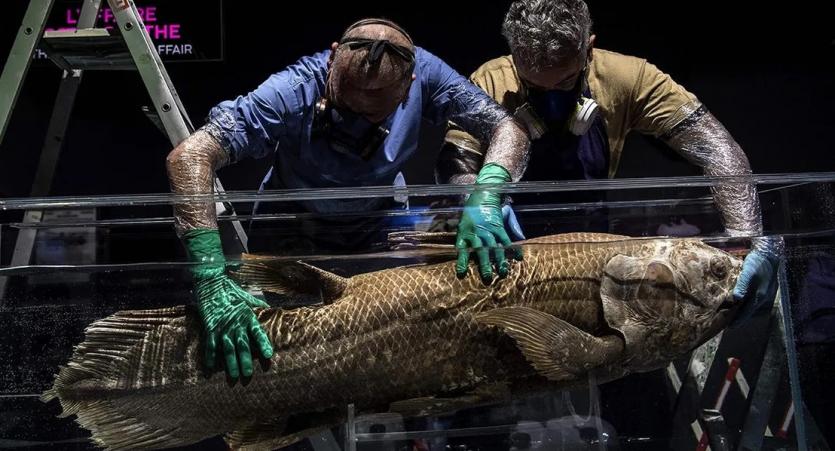Taxidermists install a coelacanth in a formol-filled tank for the 'Ocean' exhibition ahead of its opening at the National Museum of Natural History (Museum d'Histoire Naturelle) in Paris on March 29, 2019. Photo:Getty
By Patryk Krych | The World Daily | JUNE 18th 2021
Following a recent study, scientists now suggest that the coelacanth fish, a fish species that’s been alive for some 400 million years, may be able to survive for up to 100 years as opposed to the previously assumed 20-year lifespan.
Once thought to have died out alongside the dinosaurs, the slow-moving coelacanth fish were discovered to be alive in 1938 off the coasts of South Africa, shocking scientists and explorers alike for years with species’ perseverance despite history’s many apocalyptic events.
For a very long time, it was believed by scientists that the coelacanth had a lifespan of no more than 20 years or so. However, French scientists had recently discovered that they actually have the potential to live for up to a century, using a standard commercial fish dating technique, with the research published on Thursday in the journal Current Biology.
Due to the highly endangered statuses of the fish, scientists were forced to use the marks on the scales of museum specimens rather than live examples. Much like the age rings within trees, an approximate lifespan was discovered using this method.
The study stated that females of the species tend not to reach sexual maturity until their 50s, and males until after their 40s. What’s more, it’s been suggested that females carry their children through pregnancy for a total of five whole years – putting the future survivability of this species into question.
With this most recent study, however, better protections may be afforded to them, alongside more focused conservations measures, according to Dr Bruno Ernande of the University of Montpellier, France.
“One very important framework for conservation measures is to be able to assess the demography of the species,” Dr Ernande told BBC News. “With this new information we will be better able to assess it.”
Scientists are already planning future studies into the growth and life histories of coelacanth in order to figure out how their growth is related to temperature and environment, so that it may be assessed how their already strikingly low numbers may be affected by the inevitable consequences of climate change.
“Coelacanth appears to have one of, if not the slowest, life histories among marine fish, and close to those of deep-sea sharks and roughies,” said Kélig Mahé, from the North Sea Fisheries Research Unit in Boulogne-sur-mer, in France.






